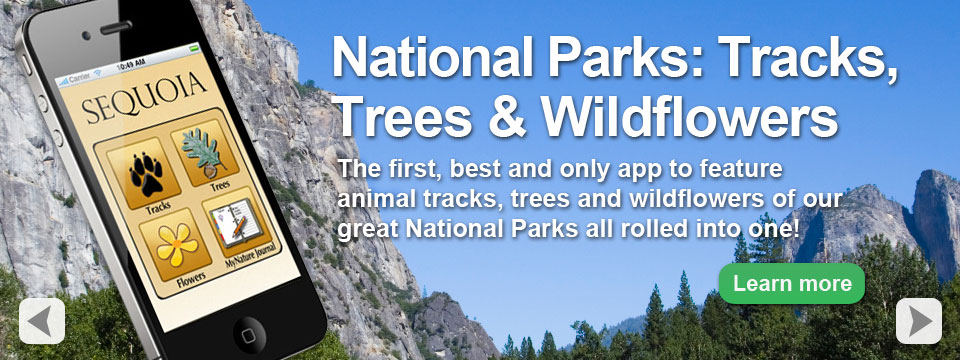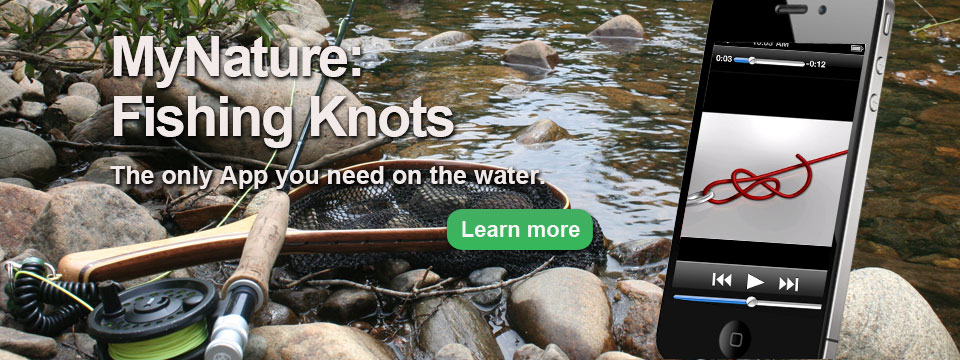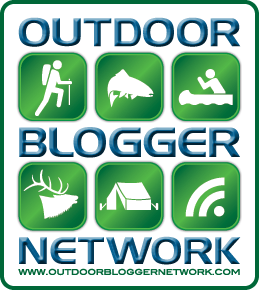That’s right, there are beavers on your iPhone but don’t worry they won’t be chewing through your memory. What beavers are on your iPhone are located in the MyNature Animal Track app. Next time you come across some unknown tracks near the waters edge you can use the app to measure the tracks, compare the outline, find out the gait pattern, see a beautiful image of one in the wild and learn about their habitat. Below are just a few pictures of what beaver sign you might find on your next outing.
Archives for January 2010
MyNature Press Release
MyNature Animal Tracks for iPhone – Only Track I.D. App on the Market – Published on 01/15/10
IMMEDIATE RELEASE
MyNature Inc. today released MyNature Animal Tracks 1.0 for iPhone and iPod Touch users. This is the first app on the market that can identify animal tracks using smart phone technology. Users can learn about the animal whose tracks they’ve found, see images, listen to the sounds they make and even find out what animals may be in the area where they are. Using categorized track illustrations, users can match what they’ve found against the listings in MyNature Animal Tracks.
North Creek, NY – Announcing that MyNature Inc., the developers of MyNature Animal Tracks, are excited about launching the first and only app that can identify animal tracks using smart phone technology. Users can learn about the animal whose tracks they’ve found, see images, listen to the sounds they make and even find out what animals may be in the area where they are.
No other application can do what MyNature Animal Tracks does. It makes an educational experience fun in new way. Using categorized track illustrations, users can match what they’ve found against the listings in MyNature Animal Tracks. After that, they can listen to vocalizations, see photos and range maps, or read more to learn about the animal that left the track. The app can also alert users to which animals they may find in any area in North America. This is helpful for being informed of the locations of dangerous, as well as interesting species. A user can then keep an eye out for specific tracks to avoid or follow.
MyNature Animal Tracks also includes a place for making notes, which is particularly useful for those who enjoy ‘collecting’ tracks. Users will find tips in this app that guide them to finding tracks, making plaster casts and other valuable information that has been gathered by nature field guides.
Some of the MyNature Animal Tracks Features
* Searchable database on track size and shape featuring 7 search categories. For example 4 toes round in shape the Felid family, 4 toes oval to square in shape the Canid family, hooved tracks, tracks with 5 toes, tracks that are birdlike and much more
* Clearly illustrated track drawings showing both fore and hind prints with track measurements along with a description of the animal’s habitat and life cycle
* Illustrated images of each animal’s common gait as well as other gait patterns they may use
* Digital images of an actual track of each animal in the wild
* Range maps to reference an animal’s presence in your location
* Sound waves of each animal’s vocalizations
* Full color digital image of what the animal looks like in its natural environment
* Handy ruler to measure and aid in track identification
* MyNature journal, where you can personally record the tracks you’ve found along with the location, weather conditions or just your own personal thoughts about your day in the field
* Tips on finding tracks, plaster casting and much more
Currently, MyNature Animal Tracks covers all animals in North America, from the smallest creature to the largest. If the track belongs to an animal on this continent, it’s in the app waiting to be discovered by users. MyNature Animal Tracks is a fully-loaded, one of a kind app that’s great for kids and adults alike. It is the most fun a nature loving person can have while learning.
Device Requirements:
iPhone or iPod Touch 3.0 or later
Pricing and Availability:
MyNature Animal Tracks is only $6.99 (USD) and available worldwide exclusively through the App Store in the Education category. Please specify the website or blog you represent when making your request.
MyNature Animal Tracks 1.0: http:/
Purchase and Download: http://itunes.apple.com/us/app/mynature-animal-tracks/id338980245?mt=8
Demonstration Video: http://www.youtube.com/watch?v=mtkHPIs2GYQ
Media Assets: http://s900.photobucket.com/albums/ac205/mynatureinc/MyNature%20Animal%20Track%20App%20Screenshots/
MyNature Inc. is devoted to educating people about nature in a simple, easy to understand format. MyNature designs field guides that are functional and enjoyable to use. Copyright (C) 2010 Edward Turner & Mobile-App-Marketing-Makeover. All Rights Reserved. Apple, the Apple logo, iPhone and iPod are registered trademarks of Apple Inc. in the U.S. and/or other countries.
###
Jeff Greco
Media Contact for MyNature Inc.
Squirrel, Cottontail or Snowshoe Hare?
Even though it’s winter and animal tracks are everywhere to be found how do you know which track belongs to what animal? Squirrels and rabbits have an almost identical track pattern and to make it worse their toes usually aren’t distinguishable in the snow. Most often you only see a group of 4 imprints that are merely oblong impressions. If you can remember a few different trail width sizes then you’ll be an expert in telling which of these three animals left the tracks you found.
 Snowshoe Hares will always have the largest trail width averaging around 6 inches wide. Once you have identified a Hares tracks you’ll never confuse them with any others. Another important thing to take notice of is where are the tracks. A Snowshoe will almost always be found in a coniferous forest. I’ve seen them in the open of hardwoods, but there was always the cover of evergreens within site.
Snowshoe Hares will always have the largest trail width averaging around 6 inches wide. Once you have identified a Hares tracks you’ll never confuse them with any others. Another important thing to take notice of is where are the tracks. A Snowshoe will almost always be found in a coniferous forest. I’ve seen them in the open of hardwoods, but there was always the cover of evergreens within site. 
This set of tracks on the right are of a Cottontail Rabbit. The trail width of a Cottontail is approximately 3 to 4 inches wide. Their feet are much narrower than a Snowshoes but the gait pattern and track pattern are identical. Cottontail tracks will usually be found in brushy areas, the thicker the brush the better the habitat for Cottontails. They will also be found along hedgerows and agricultural fields. The length of the Cottontails hind track is approximately 3 to 3 1/2 long.
 This set on the left is of a Red Squirrel. These tracks are more commonly confused with those of Cottontails. Red Squirrels as well as Gray Squirrels are more boxed shaped in the track pattern and are much smaller in length. Even though the trail width can be quite similar the rear track size will distinguish the two apart. The rear print of a Gray Squirrel will usually be just under two inches long while a Red`Squirrels rear track will be approximately 1 to 1 1/2 inches long. Depending on how deep the snow powder is squirrel tracks can appear much larger than they actually are as more of the foot and leg tend to leave an imprint.
This set on the left is of a Red Squirrel. These tracks are more commonly confused with those of Cottontails. Red Squirrels as well as Gray Squirrels are more boxed shaped in the track pattern and are much smaller in length. Even though the trail width can be quite similar the rear track size will distinguish the two apart. The rear print of a Gray Squirrel will usually be just under two inches long while a Red`Squirrels rear track will be approximately 1 to 1 1/2 inches long. Depending on how deep the snow powder is squirrel tracks can appear much larger than they actually are as more of the foot and leg tend to leave an imprint.
With that little bit of knowledge you should be able to tell these tracks apart on your next outing. Happy Hiking!!
Redtail Hawk 0, Snowshoe Hare 1
I was tracking a Snowshoe hare today and he turned out to be one tough rabbit. I came across a spot where he was attacked by an obviously hungry Redtail Hawk. I’m assuming it’s a redtail since I saw one in the area and the sign at the crime scene was as fresh as could be. 
The spot of the first attack, they wrestled around here for a few minutes. The spot is trampled so much from the Hare escaping the clutch of the hawk several times.
The hawk drew some blood at this point in the attack.
 Here is where the final attempt to catch the hare took place. The hawk did manage to get a talon full of hair but not a meal. I followed the tracks for 100 yards and with the exception of a few drops of blood the Hare was traveling at a normal gait. There was a lot of Coyote sign around so I’m sure they will be on his trail tonight. He’ll probably do fine since he seems to be one tough Snowshoe!!
Here is where the final attempt to catch the hare took place. The hawk did manage to get a talon full of hair but not a meal. I followed the tracks for 100 yards and with the exception of a few drops of blood the Hare was traveling at a normal gait. There was a lot of Coyote sign around so I’m sure they will be on his trail tonight. He’ll probably do fine since he seems to be one tough Snowshoe!!
iPhone and Animal Tracks
 As the snow starts to pile up distinguishing individual tracks of larger animals can get a little tricky. Most tracks of heavier animals fill in with snow as one foot is lifted and the next in line pushes more into the imprint. Often times their trail may just appear as a trough throw the snow obscuring most of the details. When this happens if your not lucky enough to find an identifiable print you need to look more at the animals gait pattern, trail width and stride. Not all animals traveling gaits are the same, some are bounders, some are pacers and some are diagonal walkers. Learning their gait patterns will eliminate some possibilities of which animals tracks your looking at. Just as their gait is different so to is their trail width. Trail width is the measurement from the outside of the left track to the outside of the right track. If you can distinguish in the deep snow the edges of the tracks then you have narrowed down your choices even further. The last measurement to help you out is the stride of the animal. The stride is the measurement from the back edge of one track to the back edge of the next same track. An Elk will have a larger stride than a Mule deer or Whitetail.
As the snow starts to pile up distinguishing individual tracks of larger animals can get a little tricky. Most tracks of heavier animals fill in with snow as one foot is lifted and the next in line pushes more into the imprint. Often times their trail may just appear as a trough throw the snow obscuring most of the details. When this happens if your not lucky enough to find an identifiable print you need to look more at the animals gait pattern, trail width and stride. Not all animals traveling gaits are the same, some are bounders, some are pacers and some are diagonal walkers. Learning their gait patterns will eliminate some possibilities of which animals tracks your looking at. Just as their gait is different so to is their trail width. Trail width is the measurement from the outside of the left track to the outside of the right track. If you can distinguish in the deep snow the edges of the tracks then you have narrowed down your choices even further. The last measurement to help you out is the stride of the animal. The stride is the measurement from the back edge of one track to the back edge of the next same track. An Elk will have a larger stride than a Mule deer or Whitetail.
Just because the snow gets deeper doesn’t mean identification is impossible. Next time your out bring along the MyNature Animal Track app, everything you need to know about stride, trail width and gait patterns are just a push button away. So pull on your long johns, strap on the snowshoes and hit the woods and see what’s living in your back yard.























What Others Have to Say